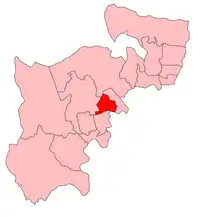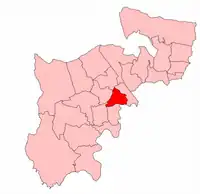Willesden West (UK Parliament constituency)
Willesden West was a constituency in Middlesex adjoining the County of London and forming part of the London conurbation, in London itself from 1965. It returned one member to the House of Commons of the UK Parliament 1918–1974.
| Willesden West | |
|---|---|
| Former Borough constituency for the House of Commons | |
| 1918–February 1974 | |
| Seats | one |
| Created from | Harrow (small part of) |
| Replaced by | Brent East and Brent South |
The outcome of the seat switched permanently to electing the Labour candidate, in 1923 — save for the four-year term when the party's number of MPs fell from 327 to 52 seats (1931-1935) and when the seat elected notable women's right advocate Mrs Mavis Tate.
History


.svg.png.webp)
Until 1918, Willesden formed part of the Harrow Division of Middlesex. The constituency was created by the Representation of the People Act 1918, and was first contested in the general election of that year. The boundaries were altered by further legislation in 1948 and the constituency was abolished when new seats based on the London Boroughs created by the London Government Act 1963 came into use for the February 1974 general election. The area of the constituency was divided between the two new seats of Brent East and Brent North.[1]
Boundaries
The 1918 legislation created a new parliamentary borough of Willesden, identical in area with the urban district of Willesden, and divided it into two single-member divisions. Willesden West comprised five of the eleven wards of the urban district: Church End, Harlesden, Roundwood, Stonebridge and Willesden Green. The remaining six wards formed the Willseden East division. In 1933 Willesden was incorporated as a municipal borough, although this made no change to the parliamentary divisions.[1]
When constituencies were redrawn prior to the 1950 general election, Willesden West was redefined in terms of seven wards of the borough as they then existed: Church End, Harlesden, Kensal Rise, Manor, Roundwood, Stonebridge and Willesden Green. Kensal Rise had previously formed part of Willesden East.[1]
Members of Parliament
| Election | Member | Party | |
|---|---|---|---|
| 1918 | Charles Pinkham | Conservative | |
| 1922 | George James Furness | Conservative | |
| 1923 | Samuel Viant | Labour | |
| 1931 | Mavis Tate | Conservative | |
| 1935 | Samuel Viant | Labour | |
| 1959 | Laurie Pavitt | Labour | |
| Feb 1974 | constituency abolished | ||
Elections
Elections in the 1910s
| Party | Candidate | Votes | % | ±% | |
|---|---|---|---|---|---|
| C | Unionist | Charles Pinkham | 10,503 | 54.1 | |
| Labour | Samuel Viant | 7,217 | 37.2 | ||
| Liberal | John Smyth Crone | 1,697 | 8.7 | ||
| Majority | 3,286 | 16.9 | |||
| Turnout | 19,417 | 53.3 | |||
| Unionist win (new seat) | |||||
| C indicates candidate endorsed by the coalition government. | |||||
Elections in the 1920s
| Party | Candidate | Votes | % | ±% | |
|---|---|---|---|---|---|
| Unionist | George James Furness | 13,328 | 51.5 | -2.6 | |
| Labour | Samuel Viant | 12,529 | 48.5 | +11.3 | |
| Majority | 799 | 3.0 | -13.9 | ||
| Turnout | 25,857 | 66.7 | +13.4 | ||
| Unionist hold | Swing | ||||
| Party | Candidate | Votes | % | ±% | |
|---|---|---|---|---|---|
| Labour | Samuel Viant | 14,004 | 51.3 | +2.8 | |
| Unionist | George James Furness | 8,256 | 30.3 | -18.2 | |
| Liberal | David Cleghorn Thomson | 5,030 | 18.4 | New | |
| Majority | 5,748 | 21.0 | N/A | ||
| Turnout | 27,290 | 69.1 | +1.4 | ||
| Labour gain from Unionist | Swing | +12.0 | |||
| Party | Candidate | Votes | % | ±% | |
|---|---|---|---|---|---|
| Labour | Samuel Viant | 14,884 | 47.3 | -4.0 | |
| Unionist | Mitford Brice | 13,539 | 43.0 | +12.7 | |
| Liberal | James McCulloch | 3,061 | 9.7 | -8.7 | |
| Majority | 1,345 | 4.3 | -16.7 | ||
| Turnout | 31,484 | 77.6 | +8.5 | ||
| Labour hold | Swing | ||||
| Party | Candidate | Votes | % | ±% | |
|---|---|---|---|---|---|
| Labour | Samuel Viant | 20,583 | 52.3 | +5.0 | |
| Unionist | Malcolm McCorquodale | 12,779 | 32.4 | -9.6 | |
| Liberal | Arthur Lewis Leighton | 6,038 | 15.3 | +5.6 | |
| Majority | 7,804 | 19.9 | +15.6 | ||
| Turnout | 39,400 | 73.4 | -4.2 | ||
| Labour hold | Swing | +7.8 | |||
Elections in the 1930s
| Party | Candidate | Votes | % | ±% | |
|---|---|---|---|---|---|
| Conservative | Mavis Tate | 23,910 | 60.6 | +28.2 | |
| Labour | Samuel Viant | 15,550 | 39.4 | -12.9 | |
| Majority | 8,360 | 21.2 | N/A | ||
| Turnout | 39,460 | 71.7 | -1.7 | ||
| Conservative gain from Labour | Swing | ||||
| Party | Candidate | Votes | % | ±% | |
|---|---|---|---|---|---|
| Labour | Samuel Viant | 19,402 | 54.1 | +14.7 | |
| Conservative | Sigmund Samuel | 16,472 | 45.9 | -14.7 | |
| Majority | 2,930 | 8.2 | N/A | ||
| Turnout | 35,874 | 64.4 | -7.3 | ||
| Labour gain from Conservative | Swing | ||||
General Election 1939–40
Another General Election was required to take place before the end of 1940. The political parties had been making preparations for an election to take place and by the Autumn of 1939, the following candidates had been selected;
- Labour: Samuel Viant[3]
- Conservative:
Elections in the 1940s
| Party | Candidate | Votes | % | ±% | |
|---|---|---|---|---|---|
| Labour | Samuel Viant | 26,566 | 72.2 | +18.1 | |
| Conservative | JB Cartland | 10,236 | 27.8 | -18.1 | |
| Majority | 16,330 | 44.4 | +36.2 | ||
| Turnout | 36,802 | 70.5 | +6.1 | ||
| Labour hold | Swing | ||||
Elections in the 1950s
| Party | Candidate | Votes | % | ±% | |
|---|---|---|---|---|---|
| Labour | Samuel Viant | 33,963 | 61.1 | -11.1 | |
| Conservative | Attracta Rewcastle | 17,848 | 32.1 | +3.3 | |
| Liberal | Sirdar Karan S.B. Ahluwalia | 2,853 | 5.1 | New | |
| Communist | David Michaelson[5] | 938 | 1.7 | New | |
| Majority | 16,115 | 29.0 | -15.4 | ||
| Turnout | 55,602 | 83.2 | +12.7 | ||
| Labour hold | Swing | ||||
| Party | Candidate | Votes | % | ±% | |
|---|---|---|---|---|---|
| Labour | Samuel Viant | 35,296 | 64.3 | +3.2 | |
| Conservative | John L Bott | 19,632 | 35.7 | +3.6 | |
| Majority | 15,664 | 28.6 | -0.4 | ||
| Turnout | 54,928 | ||||
| Labour hold | Swing | ||||
| Party | Candidate | Votes | % | ±% | |
|---|---|---|---|---|---|
| Labour | Samuel Viant | 29,185 | 61.8 | -2.5 | |
| Conservative | Peter B Kenyon | 18,074 | 38.2 | +2.5 | |
| Majority | 11,111 | 23.6 | -5.0 | ||
| Turnout | 47,259 | 74.4 | |||
| Labour hold | Swing | -2.5 | |||
| Party | Candidate | Votes | % | ±% | |
|---|---|---|---|---|---|
| Labour Co-op | Laurence Pavitt | 25,680 | 57.2 | -4.6 | |
| Conservative | Pamela S Brookes | 17,946 | 39.9 | +1.7 | |
| Communist | Leslie G Burt | 1,324 | 2.9 | New | |
| Majority | 7,734 | 17.3 | -5.7 | ||
| Turnout | 44,950 | 73.0 | -1.4 | ||
| Labour Co-op hold | Swing | ||||
Elections in the 1960s
| Party | Candidate | Votes | % | ±% | |
|---|---|---|---|---|---|
| Labour Co-op | Laurence Pavitt | 23,862 | 62.8 | +5.6 | |
| Conservative | John S Grose | 12,961 | 34.2 | -5.7 | |
| Communist | Leslie G Burt | 1,130 | 3.0 | +0.1 | |
| Majority | 10,901 | 28.6 | +11.3 | ||
| Turnout | 37,953 | 63.5 | -9.5 | ||
| Labour Co-op hold | Swing | ||||
| Party | Candidate | Votes | % | ±% | |
|---|---|---|---|---|---|
| Labour Co-op | Laurence Pavitt | 24,944 | 68.5 | +5.7 | |
| Conservative | A Pamela Thomas | 10,362 | 28.4 | -5.7 | |
| Communist | Leslie G Burt | 1,140 | 3.1 | +0.1 | |
| Majority | 14,582 | 40.1 | +11.5 | ||
| Turnout | 36,446 | 63.6 | +0.1 | ||
| Labour Co-op hold | Swing | +5.7 | |||
Elections in the 1970s
| Party | Candidate | Votes | % | ±% | |
|---|---|---|---|---|---|
| Labour Co-op | Laurence Pavitt | 21,918 | 67.2 | -1.3 | |
| Conservative | Ronald F Dyason | 10,163 | 31.2 | +2.8 | |
| Communist | Leslie G Burt | 515 | 1.6 | -1.5 | |
| Majority | 11,755 | 36.0 | -4.1 | ||
| Turnout | 32,596 | 59.3 | -4.3 | ||
| Labour Co-op hold | Swing | +2.0 | |||
References
- Youngs, Frederic A Jr. (1979). Guide to the Local Administrative Units of England, Vol.I: Southern England. London: Royal Historical Society. pp. 745–748. ISBN 0-901050-67-9.
- British Parliamentary Election Results 1918-1949, FWS Craig
- Report of the Annual Conference of the Labour Party, 1939
- British parliamentary election results, 1950-1973 by FWS Craig
- Walker, Michael. "Michaelson David". Retrieved 30 April 2017.
- F W S Craig, British Parliamentary Election Results 1950-1973; Political Reference Publications, Glasgow 1973